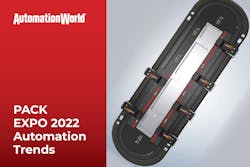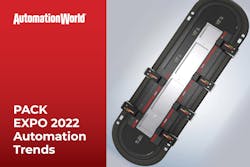
Quick hits:
- Beckhoff adds no-cable technology to its XTS (eXtended Transport System).
- Stratus Technologies and Schneider Electric show how micro data centers can be used for automation and control.
- Festo AX applies artificial intelligence for preventive maintenance of components, machines, and systems.
Related to this episode:
Welcome to Automation World’s Technology Matters. I’m David Greenfield, Director of Content, and today I’m going to highlight some of the key automation trends that were on display last week at PACK EXPO International in Chicago.
Let’s start with the new no-cable technology update to Beckhoff’s eXtended Transport System, typically referred to as XTS. If you’re unfamiliar with XTS, it’s a materials handling system with movers that can move independently or be synchronized in groups for material handling in a variety of consumer packaged goods processing and packaging applications. For example, tooling on the XTS movers can be used to open and close bags and cap bottles, among an array of other possible tasks.
This new no-cable XTS brings contactless, continuous power supply and synchronous real-time data transmission to the XTS movers. To enable this, a special motor module and electronics have been added to the XTS system, meaning that no additional connections or supply lines are required. This allows for processing steps and quality control to be accomplished directly on the mover while a process is running.
Beckhoff’s Jeff Johnson said: with traditional linear transport systems, if you wanted to grip something you'd have to have two movers mechanically linked to do the gripping. Now that Beckhoff has integrated power and data on the movers, you can mount things like vacuum generators on the movers to do vacuum pickup of materials—or use any end of arm robot tooling on the movers to pick and place product.
A few new applications made possible by the XTS no-cable technology include the ability to:
- divide and reunite product flows using mechatronic transfers between two movers;
- sort products using an integrated pusher on the mover;
- pick and place products using vacuum suction units; and
- pick up individual products from unsorted and irregular product flows and sort them into good and bad parts or place them correctly for final packaging.
Another interesting automation development involves micro data centers. This may seem unusual since data centers are typically large areas used by enterprise IT departments to house routers, switches, firewalls, storage systems, and servers. But micro data centers are small, modular versions of data centers used to manage computing workloads for specific operations.
At PACK EXPO, Stratus and Schneider Electric exhibited three sizes of the Ecostruxure micro data center, which feature the Stratus ftServer, for use in consumer packages goods and pharmaceutical applications.
Key features of the ftServer include embedded cybersecurity, no unscheduled downtime with its failure prediction capabilities, and remote monitoring. These features are key for the type of operations technology use Schneider Electric and Stratus were highlighting at PACK EXPO, which centered on the micro data centers ability to house—not just IT communications and storage gear—but HMI, SCADA, historians, batch processing, manufacturing execution systems, asset performance management, and cybersecurity systems. Jay David with Stratus said: the Micro Data Center can replace any or all the components associated with a server control panel, such as automation and control software, the computers where the software is installed, UPS and power supplies, and networking equipment.
And to show how artificial intelligence can be used in CPG production operations, Festo introduced its Festo Automation Experience, referred to as Festo AX, at PACK EXPO. By using advanced analytics, Festo AX maps device and equipment data to learn a component, machine, product, or system’s healthy state and provide information for the correction of anomalies when operating data begins trending out of the normal range.
Festo AX begins with condition monitoring and preventive maintenance calculations for components, machines, and systems. For these applications, data collected from the factory floor is used to make uptime-based maintenance suggestions. From this starting point, the capabilities of Festo AX can be extended with Festo’s AI technology to analyze live data in real time, meaning that users are made aware as soon as an anomaly occurs.
While Festo AX, of course, works with any Festo components, its use of common industrial communications technologies such as OPC UA and MQTT means that it can also be integrated with third-party components and machines. According to Festo, Festo AX can lower waste by more than 50%, reduce product rejection costs by more than 45%, increase machine availability by more than 25%, and reduce unplanned downtime by more than 20%.
So I hope you enjoyed this Technology Matters episode. Keep watching this space for regular updates on advances in and applications of industrial automation technology.
